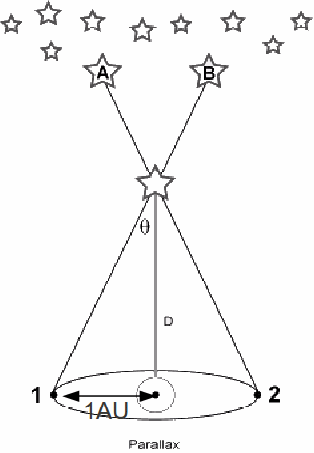As you move from one position to another, objects change their relative positions. As far as you are concerned, near objects appear to move relative to objects much further away. Objects that are very far away do not appear to move at all. You can demonstrate this yourself by closing one eye and moving your head from side to side. An object near to you will appear to move when compared with an object further away.
This apparent movement is known as parallax and can be used to measure the distance to some of the nearest stars in our galaxy All stars appear to move over the course of a night, but some appear to move relative to other stars over the period of a year. This change in observing position means that a nearby star will have an apparent movement when compared with more distant stars. The closer the star to Earth, the greater will be it's parallax.
Since all stars are very distant, the effect is a very small one and the parallax angle is very small. It is usual to quote the angle in seconds of arc (![]() ). One second of arc is equivalent to a distance of
). One second of arc is equivalent to a distance of![]() the distance subtended by 1 AU at that distance.
the distance subtended by 1 AU at that distance.

We can write![]() so
so![]() so if
so if![]() is in arcseconds then D is in parsecs.
is in arcseconds then D is in parsecs.
Example: The star Alpha Eridani subtends a parallax angle of 0.23''. It is therefore at a distance of![]()
